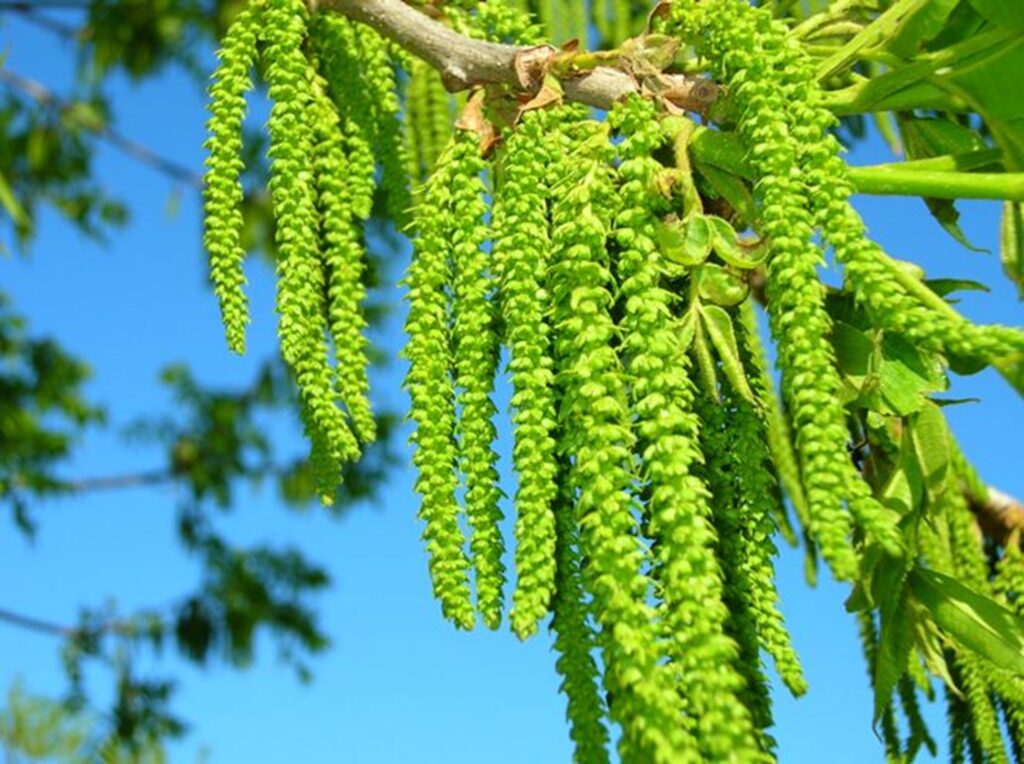The Floodplain of the Nueces River; Massive Tree Death Progressing
Pecan trees are heavily dependent on a constant source of water to produce full, good tasting nuts. Deprive the tree of water at various times of the year and you get small leaves, small nuts or empty, hollow shells. There are no shortcuts when it comes to producing the type of nuts people want to bite into at Thanksgiving; the tree must get water at regular intervals throughout the growing season.
In our orchard, we have three sources of water to get us through the growing season. We normally receive 23 inches of rain throughout the year; we are located next to the Nueces River and we have a decent aquifer, the Carrizo, underneath us. We use pumps to move the water from either the river or the aquifer to the rows of thirsty, growing trees. In a normal year, we watch the radar for rain, and when we see a dry spell forecasted, we turn on the river pumps to accomplish our irrigation. And in an emergency, well, we can always pump from the deep aquifer below us.
So what could go wrong with this nice, bucolic picture? In a word…..everything. South Texas is entering year five of the drought, perhaps the worst drought of all time. It didn’t rain but 6 inches in 2008, and so far this year we have received about 3 inches of rain. The Nueces River has not had any water flowing in it during the past five years; the riverbed is a dry trail of exposed stones and baked brown dirt. It has simply stopped raining in South Texas, and we are on the verge of turning into another Dust Bowl. According to Texas State Climatologist John Nielsen-Gammon, the rainfall between October of 2010 and May of 2011 was the lowest since record keeping began in 1895.
The Drought Makes National News
When knowledgeable people discuss droughts in Texas, the reference period that is usually brought up is the seven year stretch in the mid 1950’s. The writer Elmer Kelton referred to it as ” The Time It Never Rained…”. Year after year, the spring rains never came, the grass never turned green, and slowly, most of the great cattle herds were sold off or they perished. Day after day, people looked up at a brilliant blue sky, and prayed that they would see a rain cloud. And for years on end, they didn’t; there were only more hot sunny days, and a parched earth under their feet. Towards the end of the 1950’s, the state considered building a huge canal system to bring water from the rainier, eastern part of the state to the arid western part. Of course, once the rains started to fall, the project was put on a shelf somewhere to collect dust.
During the 1950’s, the state of Texas had a population of 8 million people. Today, there are over 25 million people in Texas. A number of large reservoirs were built in the 60’s, while the memory of the drought was still fresh. But as time passed, fewer reservoirs were built, and most of the ones proposed over the last forty years were stopped by local groups that wanted no change to their environment. The result of this indifference as the drought worsens is predictable; the fight over every existing source of water is growing.
When it comes to entities that are habitually short of water, the City of San Antonio sits in a league all by itself. From a hydrological perspective, San Antonio sits atop a small sliver of the environmentally sensitive Edwards aquifer. It doesn’t take much pumping to threaten the flow at two historic springs, the San Marcos Springs and Barton Springs, and so the city simply cannot expand their production of ground water. There are limited supplies of surface water, and in fact the famed Riverwalk would run dry if the tail water wasn’t recirculated to the beginning of the watercourse as it winds its way through the downtown section.
Over the years, San Antonio has proposed a number of whacky solutions to help solve its water woes. One solution sought to pump water from the Colorado River in Matagorda County through a 170 mile pipeline to the city. This would have required the water to be lifted uphill, as the elevation difference between the river and the city was over 700 feet. The energy needed to pump this water, day in and day out, was enormous, and so this plan was quietly shelved. Well, maybe not so quietly, as the City has filed suit against the proposed supplier of water, the LCRA, leaving suitor and suitee locked in a legal embrace for years to come.
More recently, San Antonio looked west, and proposed another 70 mile pipeline project that would move water from the Uvalde area to the western part of San Antonio. Now, unfortunately, in almost any part of Texas, you can find some third generation ne’er do wells who will sell water rights, easement rights for electrical transmission lines or even the aged wood off the old barn for a little beer money. The fact that this will cause hardship to all the local farmers who are still actually getting up each day and trying to earn an honest living is of little matter to these types. The Texas legislature took a look at this, and said nothing doing. So for now, this project is at a dead end, but with a growing population, San Antonio will be forced to continue its search for a source of water that will allow the city to keep its numerous car washes and water amusement parks operating.
One group has been able to jump right into the water fray and establish itself as an entity to be reckoned with. We refer, of course, to the oil industry, from the giants, such as Exxon on down to all the smaller players. With the discovery of the Eagle Ford Shale play, the south Texas region is in the midst of a massive oil boom. But unlike booms of the past, this new drilling employs the hydraulic fracturing of the rock, and massive amounts of water are required to execute this technique. With so little water available, the oil companies have been drilling numerous wells into the Carrizo aquifer. They are pumping out so much water that the aquifer level has been dropping precipitously over the past two years. Of course, the region has numerous Underground Water Conservation Districts, to restrict the drilling of new wells and ensure that the existing water users, who are mainly agricultural, continue to have a source of water. Unfortunately, most of the ag users don’t have 50 person Legal departments back in Houston, and apparently, if you are an oil company, you are exempt from all local regulations anyway. We can ony hope that some of the well funded environmental defense groups will step into the void and investigate how the oil companies have been able to establish a stranglehold on the South Texas groundwater supply.
For now, the drought continues, and each hot, sunny, 110 degree day exhausts a little bit more of our water supply. Farmers and ranchers continue to take the brunt of the pain and damage caused by the lack of rain. Some farmers, their cotton and corn crop shriveled by having no moisture during the growing season, will call it quits, and other farmers will be told by their banker to put a ‘For Sale’ sign up on the place. Those who remain will question their own sanity. It has gotten to the point where the only course of action left is to “Pray For Rain”. So, to all who enjoy eating great tasting, organic pecans, we ask that you say a small prayer; hopefully Mother Nature will do the rest.
Written on Saturday, 25 June 2011 11:17 by Bob Ackerley




